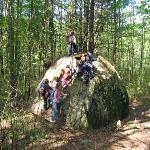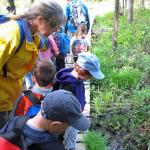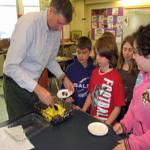25 June 2010

Photo: VOA - N. Keck
At Calvary Preschool in Pittsford, Vermont, nearly one-third of class time is devoted to active, outdoor play.
At a preschool in Pittsford, Vermont, nearly one-third of class time is devoted to active, outdoor play.
The idea of having to teach kids how to play outside leaves Anita Caldwell, a teacher at Calvary Preschool in Pittsford, Vermont, dumbfounded.
"You just kind of take for granted that kids want to go outside and play but then you recognize, when you talk to them, that they don't," says Caldwell. "They spend their day with a large screen TV and some snacks."
Fellow teacher, Laura Peterson, agrees. "When I was growing up - 'shoo!' - out the door in the morning and you'd play outside until the streetlights came on at night."
But it's different today, she says. With many parents working, it's often easier for them to have their kids play inside with a video game or watch TV.
Peterson says an early childhood education class got her thinking about ways to incorporate more activity into their school day. She began to research playground equipment and found many experts touting the benefits of 'back to nature' unstructured play.

VOA- N. Keck
Teacher Laura Peterson and her students examine a stream during Hike Day.Hike day
Calvary preschool is located near a series of hiking trails, so Peterson approached her colleagues and together they revised their three day teaching schedule so that every Friday is hike day.
Teacher Joanne Pye says 15 kids come to the morning session while another 15 attend in the afternoon.
"Fridays we are only inside for half an hour to gather together. We meet, we talk about what the hike is for the day, and then they pack their backpacks and we head out the door - no matter what the weather."
Pye has seen dramatic changes in the kids because of their weekly hike day.
"At the beginning of the year, it seemed like [the kids would say] 'Oh, I'm getting tired, this is too long - when are we going back to school?' And now on Monday mornings they come in and say, 'Is this hike day?' So it's changed completely."
Loosening up
Teacher Laura Peterson says kids today are more used to structured play, where they have to follow rules, listen to a coach, or play on specific equipment. So, she says, their first big challenge was getting the kids to freely explore the things along the trail.
"Then we started to go off the trail into the woods, and the kids were floored. They had no idea what to do. I said, 'Wow, look at all these trees, let's play!' And they kind of looked at me, 'What are you talking about?' So we had to show them how to walk on trees and how to swing off of them onto other branches and see the little holes underneath that you can play in."
Halfway along the hike, teacher Joanne Pye stops near a huge boulder. Within seconds, the kids are climbing all over it, like ants on honey.
"The first time we visited this rock last fall - there were maybe one or two children out of 15 who knew how to climb up this," says Pye.
"Research shows that if children are exposed to the outdoors between the ages of 1 and 6, they're going to love the outdoors and want more of it, and hopefully they'll become responsible for their environment."
At a time when many schools have cut back on their physical education programs, Calvary's weekly hike day is unique. Teacher Laura Peterson says they got their inspiration from a teaching method that originated in Germany in the 1960s. Preschoolers who attend these so-called 'forest kindergartens' spend all their time learning outside from nature.
While a handful of U-S schools have incorporated the teaching method, Peterson felt it was a bit too drastic a change for their public preschool. One day a week outside probably isn't enough, she says. But as she watches her students run through the woods, she smiles, and says it's a good start.

VOA - N. Keck
Brook Burnham prepares the daily fruit and vegetable snack at Mettawee Community School in West Pawlet, Vermont.Eating well
More schools are focusing on help children make good food choices. In Vermont, 57 schools are using snack time to encourage kids to eat more fruits and vegetables.
During snack time at Mettawee Community School in West Pawlet, all eyes are on Brook Burnham as she wheels her food cart from classroom to classroom.
The 190 youngsters at Mettawee enjoy fresh fruits and vegetables every morning, thanks to a $13,000 grant funded by the U.S. Department of Agriculture. To qualify, a school has to have a high percentage of low income students.
Heather Champney, Mettawee's kitchen manager, says they couldn't afford the fruit, or a part-time employee to prepare it, without the funding. "Just for an average for the month of March, we spent $1,300 just on the fruit and vegetables."
Champney believes it's money well spent, since so many kids don't get fresh fruits or vegetables at home.

VOA - N. Keck
Fourth grade teacher Mark Rampone dishes out the fruit snack for his students.Health benefits
Mandy Mayer is Mettowee's nurse and health coordinator.
"We can stand up in front of a class as much as we want and lecture them about healthy eating," says Mandy Mayer, Mettowee's nurse and health coordinator. But for the kids to really absorb and practice what they learn, Mayer believes hands-on modeling is what works best.
"They have to have the fruits and vegetables there every day, so they can see this is what we do. They'll be hungry, they're ready for it and all together as a class they're sharing in wholesome foods."
It's a lesson some of the children have already learned.
"Yeah - because the choices we make now can affect who we are when we grow up," says Autumn Manning who is 12. "Like, if we get into the habit of eating fresh fruits and veggies now, we'll be more likely to eat them later on because we'll already have formed the habit. And a lot of people just stick with the habits they form as children."
Lesson learned
Her classmate Emily Couper says it's also a lesson kids are bringing home.
"Yesterday, me and my mom were at the store and I asked her to pick up some kiwi because that was a fruit that I had here and I really enjoyed it."
Officials at the U.S. Department of Agriculture say schools in all fifty states are participating in the fresh fruits and vegetables program and the response has been overwhelmingly positive.
Because it has been offered nationally for less than two years, there is little scientific data on the program's effectiveness. But officials say anecdotal evidence has encouraged the agency to boost funding from $40 million to $150 million annually, so that more schools will be able to take part next year.